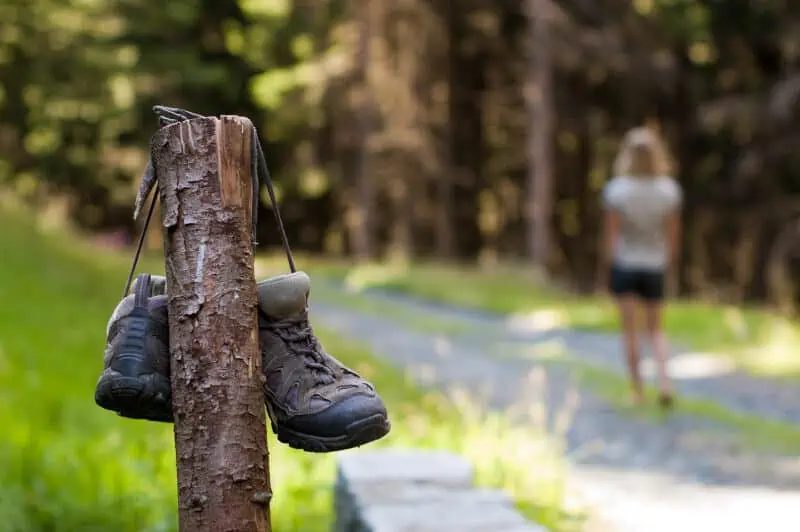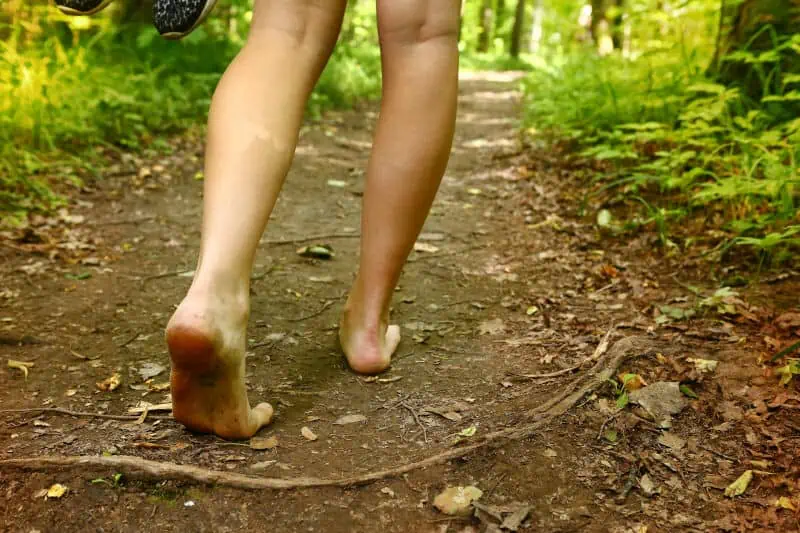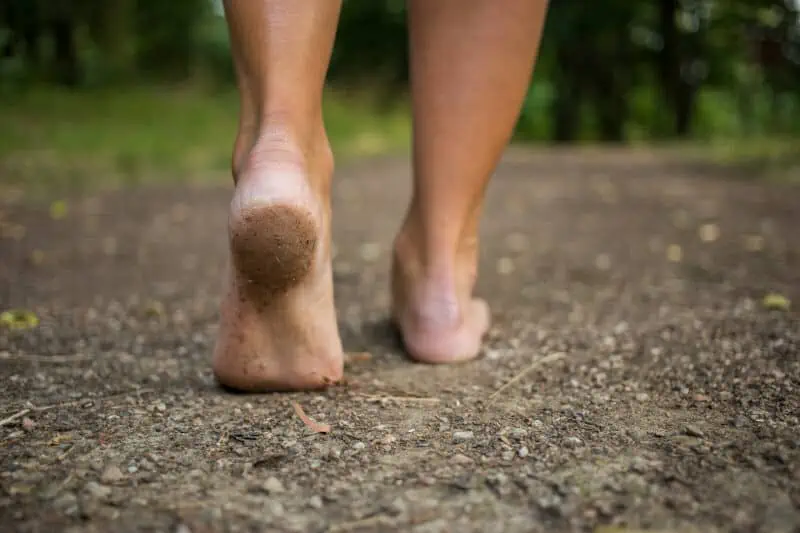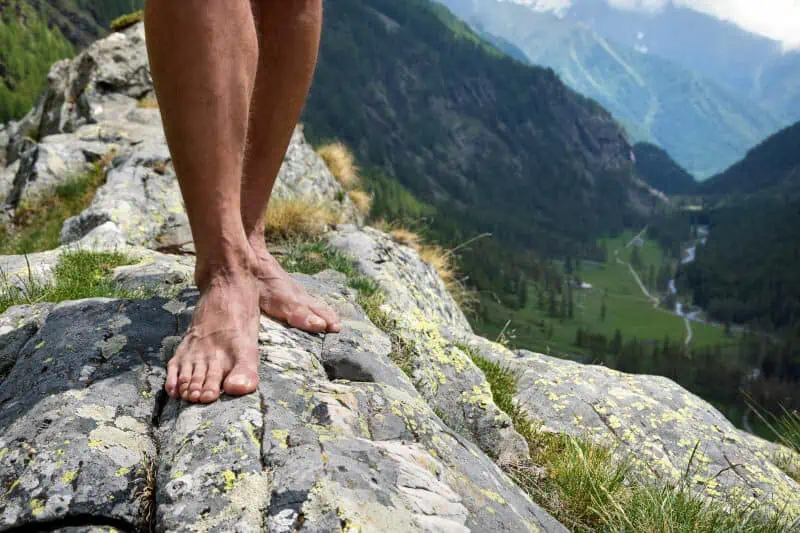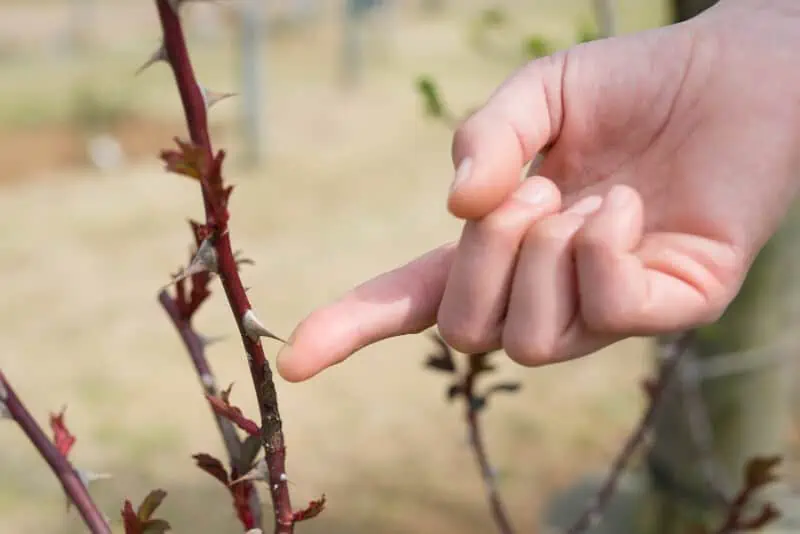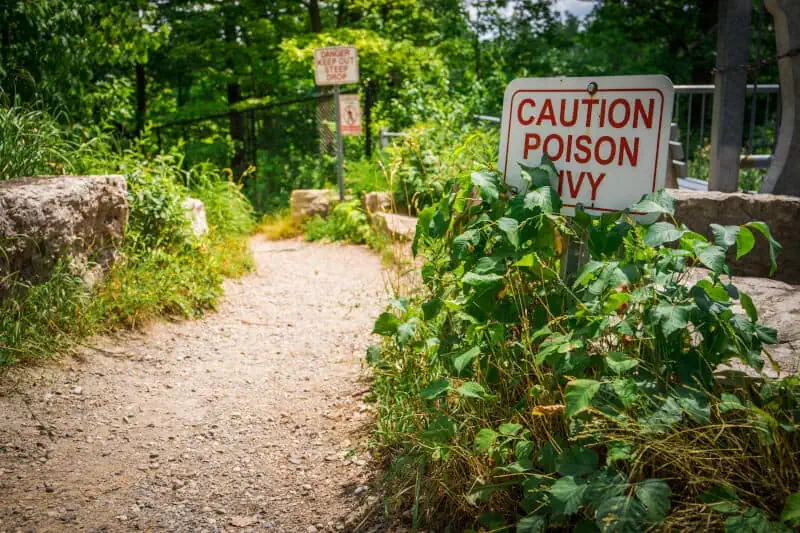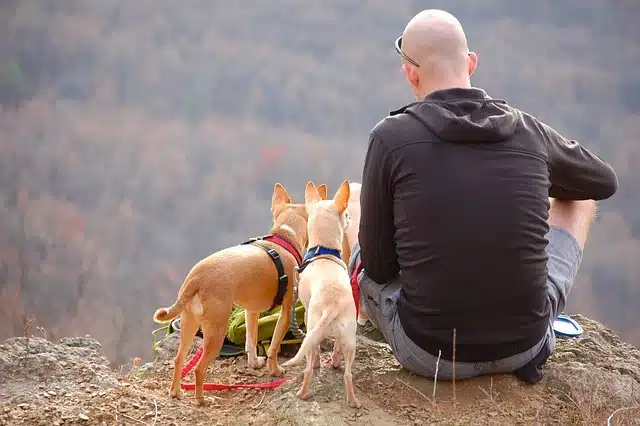In a world where technology and modern conveniences often distance us from nature, the idea of hiking barefoot presents a refreshing, albeit unconventional, approach to reconnecting with the earth. The sensation of soil, grass, and rocky terrain beneath our feet can evoke a primal and profoundly liberating experience. But is this practice as beneficial for our feet as it is for our spirit?
In this article, we will explore the burgeoning trend of barefoot hiking. We’ll delve into the science behind it, examining the potential benefits and risks associated with this naturalistic approach to trekking. From the whispered tales of ancient paths tread by our ancestors to the modern trails that beckon the adventurous soul, we will uncover the truths and myths surrounding this intriguing practice.
So, lace up your… actually, scratch that. Kick off your shoes, and let’s embark on a journey to discover if hiking barefoot is truly good for your feet. Stay tuned as we tread into the unknown, one bare step at a time.
Firstly, Human Feet Were Designed to Walk Barefoot
Our journey into the world of barefoot hiking takes us first to a fundamental truth about human anatomy: our feet were, in their original design, crafted for barefoot walking. Before the advent of modern footwear, our ancestors traversed diverse terrains, from the soft, yielding earth of forest floors to the rugged, uneven surfaces of rocky outcrops, all without the protection or constraint of shoes.
The human foot is a marvel of evolutionary engineering. Comprising 26 bones, 33 joints, and over 100 muscles, tendons, and ligaments, it’s a structure designed for flexibility, sensitivity, and strength. Walking barefoot, therefore, is not just a return to an ancestral practice; it’s a harmonization with the natural function of our bodies.
Embracing the Ground’s Natural Feedback
When we walk barefoot, our feet interact directly with the ground, providing a sensory feedback loop that shoes typically mute. This interaction enables the intricate structures in our feet to adjust and respond dynamically to varied terrains. Such responsiveness can potentially lead to stronger foot muscles, improved balance, and a more natural gait.
The Role of Sensory Input
The soles of our feet are rich with nerve endings, sensitive to a variety of stimuli. Walking barefoot allows these nerve endings to send detailed information to our brains about the ground we’re walking on. This sensory input can enhance our awareness of our surroundings, contributing to a more mindful and engaged hiking experience.
Benefits of Barefoot Walking
Several studies have explored the potential health benefits of walking barefoot, commonly referred to as “earthing” or “grounding.” These studies suggest a range of positive effects on the body, although it’s important to note that more research is needed in this area to fully understand the extent and mechanisms of these benefits.
Reduction in Inflammation
Research indicates that the electrons present in the earth have antioxidant effects that can help the body heal from inflammation, potentially reducing the risk of chronic diseases and premature aging. This is believed to be due to the electrons from the earth neutralizing free radicals that can damage healthy cells.
Improved Blood Flow and Blood Pressure
Earthing has been found to influence physiological processes such as blood flow, potentially leading to improvements in cardiovascular health. This includes the possibility of reduced blood pressure and improved blood cell dynamics, contributing to overall heart health.
Energy Boost and Fatigue Reduction
Many individuals who practice grounding report a feeling of revitalization and increased energy levels. This could be attributed to the body absorbing higher frequencies released by nature, which in turn might help in restoring balance and maintaining high energy levels throughout the day.
Improved Sleep Patterns
Earthing is suggested to have a positive impact on sleep, possibly due to its effects on circadian rhythms and the reduction of stress and anxiety. This can lead to better sleep quality and help in managing conditions like insomnia.
Stress and Anxiety Reduction
Walking barefoot outdoors is associated with reduced levels of stress and anxiety. This benefit could be a result of the direct contact with the earth, as well as the general calming effects of being in nature.
Improved Immune Function
Some studies suggest that grounding can boost the immune system, making the body less vulnerable to diseases. This is thought to be due to the absorption of electrons from the earth, which can support the immune system’s functioning.
While these findings are promising, it’s important to approach them with a degree of caution and skepticism, as the field of earthing research is still relatively new and evolving. Moreover, the experience and benefits of walking barefoot can vary greatly among individuals. Always consult with a healthcare professional before making significant changes to your health and wellness routines, especially if you have existing medical conditions.
Scientific Studies on Walking Barefoot
Scientific research has provided intriguing insights into the effects of habitual barefoot walking and running. A systematic review by Karsten Hollander (2017) aimed to evaluate the long-term effects of habitual barefoot (HB) versus shod locomotion on various parameters, including foot anthropometrics, biomechanics, motor performance, and pathologies. This review, which encompassed 15 studies with 8,399 participants, found limited evidence for certain biomechanical changes in HB populations, such as reduced ankle dorsiflexion at footstrike and a lower hallux angle. Interestingly, it was noted that HB populations had wider feet, though not necessarily shorter, compared to those who habitually wore shoes. However, no significant differences were observed in relative injury rates, with limited evidence suggesting a variation in the body part distribution of musculoskeletal injuries. The study concluded that the evidence for long-term effects of HB locomotion on biomechanics or health-related outcomes is limited or very limited, highlighting the need for more prospective research in this area.
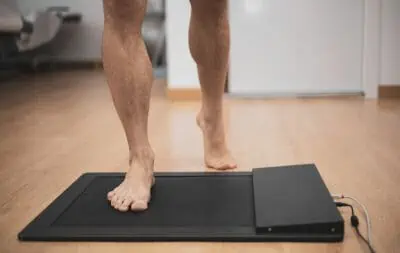
Another study, conducted by the University of Liverpool, focused on the transition from conventional to minimal footwear over a six-month period. This study observed changes in foot strength among participants who switched from conventional footwear to minimal footwear, which is considered a closer experience to barefoot walking. The intervention group was required to wear minimal footwear for at least 70% of the time they were shod and for a minimum of six days per week. The study was demanding in terms of participant recruitment, retention, and measurement, but it provided valuable insights into the potential benefits of transitioning to a more barefoot-like walking experience. The researchers measured various biometrics and foot strength before and after the intervention period, contributing to a better understanding of how minimal footwear influences foot strength and mechanics.
These studies highlight the complexity and individual variability in the effects of barefoot walking. While some benefits are noted, particularly in terms of biomechanics and foot strength, the overall evidence remains limited, and the scientific community recommends a cautious and personalized approach to transitioning to barefoot or minimal footwear activities.
Training for Barefoot Hiking
Transitioning to barefoot hiking requires a gradual approach and dedicated training to ensure your feet adapt properly and to reduce the risk of injury. Here’s a guide on how to train for barefoot hiking:
1. Start Slowly
- Initial Steps: Begin by walking barefoot around your home or in other safe environments. This helps your feet get used to the sensation of different textures without the risk of injury.
- Gradual Increase: Gradually increase the time you spend barefoot each day. This slow progression allows the muscles in your feet to strengthen and adapt.
2. Strengthen Your Feet
- Exercises: Incorporate foot-strengthening exercises into your routine. Toe curls, heel raises, and spreading your toes can help build foot strength.
- Balance Training: Practice balance exercises to improve your foot’s proprioception (awareness of body position). Standing on one foot or using a balance board can be effective.
3. Condition Your Skin
- Toughening the Skin: As you spend more time barefoot, the skin on your feet will gradually toughen. Walking on different surfaces, like grass, sand, and smooth pavement, can help with this process.
- Moisturizing: It’s important to keep your feet well-moisturized to prevent cracks and maintain healthy skin.
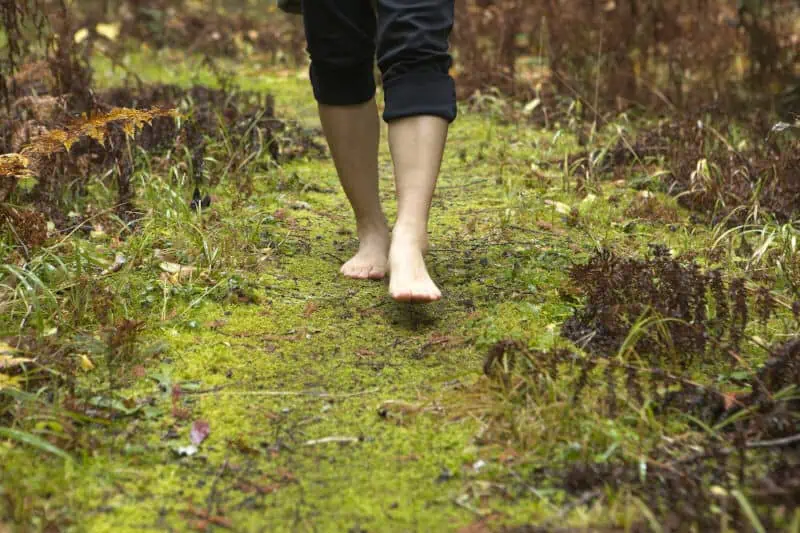
4. Mindful Walking
- Focus on Form: Pay attention to your walking form. Aim for a natural gait, landing softly on your feet, and avoiding overstriding.
- Sensory Awareness: Enhance your awareness of the ground beneath you. Being mindful of where you step can help prevent injuries.
5. Progress to Rougher Terrain
- Gradual Terrain Challenge: Once you’re comfortable walking on smooth surfaces, start introducing more challenging terrains like gravel or forest trails.
- Listen to Your Body: Pay attention to any discomfort or pain. If you experience any, it’s a sign to slow down and give your feet more time to adapt.
6. Build Endurance
- Increasing Distance: Slowly increase the distance you walk or hike barefoot. Building endurance is key to enjoying longer barefoot hikes.
- Regular Practice: Consistency is important. Try to incorporate barefoot walking into your daily routine.
7. Safety and Hygiene
- Regular Foot Checks: Regularly inspect your feet for cuts, bruises, or any signs of injury.
- Cleanliness: Keeping your feet clean after each session is crucial to prevent infections.
Training for barefoot hiking is a journey that requires patience, consistency, and mindfulness. By gradually preparing your feet and body, you can safely enjoy the unique benefits and experiences that come with hiking barefoot. Always remember to listen to your body and proceed at a pace that feels comfortable for you.
Is it Safe to Hike Barefoot?
While barefoot hiking may strengthen feet and improve balance, it’s essential to pay attention to the terrain you’re walking on. Rocks and roots present particular hazards when walking barefoot as they may cause cuts, scrapes, stubbed toes, or broken bones when hiking barefoot.
Walking barefoot may expose you to harmful plants like poison ivy, poison oak, and poison sumac that can cause an itchy blistering rash. Furthermore, walking barefoot increases your risk of encountering thistles, cacti, and stinging nettles, as well as wild animals such as snakes, spiders, scorpions, or insects like bees or wasps that might want a snack!
As with any form of hiking, one potential drawback of barefoot hiking can be that your pace may slow due to paying more attention to where your feet land than when wearing shoes. While this may be frustrating for hikers looking for fast traversals of their destination, it can also allow for full appreciation of both trail and surroundings; moreover, hiking barefoot allows one to feel changes in the environment, such as changes in temperature or coolness of ground temperatures which may prove quite rewarding – you might just find yourself wanting to hike more often this way!
The Dangers of Barefoot Hiking
While barefoot hiking can offer a unique and natural experience, it’s important to be aware of the potential dangers associated with this activity. The lack of protection for the feet can increase the risk of various injuries and health issues. Below are some of the key dangers to consider:
Splinters
- Risk: Barefoot hikers are at risk of stepping on splinters or sharp objects like thorns and broken twigs.
- Precaution: Hikers should choose their trails carefully, avoiding paths with known debris or broken wood. Regularly checking the feet for splinters and knowing how to safely remove them is also important.
Injuries
- Types: The most common injuries include cuts, bruises, puncture wounds, and abrasions.
- Precaution: Building up foot strength and skin thickness gradually can provide some protection. Also, being extra vigilant about where you step is crucial.
Animals
- Risk: Stepping on small animals, insects, or coming into contact with venomous creatures like snakes or scorpions.
- Precaution: Stay alert and avoid hiking in areas known for dangerous wildlife. Making noise while hiking can also help to deter some animals.
Plants
- Hazards: Poisonous plants, such as poison ivy, poison oak, or stinging nettles, pose a risk.
- Precaution: Learn to identify harmful plants and avoid areas where they are prevalent. Wearing minimal footwear in high-risk areas can provide some protection.
Tetanus
- Risk: Cuts or punctures obtained while hiking barefoot could become infected with bacteria that cause tetanus.
- Precaution: Ensure tetanus vaccinations are up to date. Clean and treat any wounds immediately and seek medical attention for serious injuries.
Parasitical Infections
- Types: Hookworm, strongyloidiasis, and cutaneous larva migrans are some parasitic infections that can be contracted through soil.
- Precaution: Avoid hiking barefoot in areas known for such parasites, especially in tropical or subtropical regions. Hiking in dry, clean areas and avoiding animal feces can reduce risk.
While the experience of hiking barefoot can be liberating and connect you more closely with nature, it’s crucial to be aware of the potential risks and take appropriate precautions. By being informed and prepared, you can enjoy the benefits of barefoot hiking while minimizing the dangers.
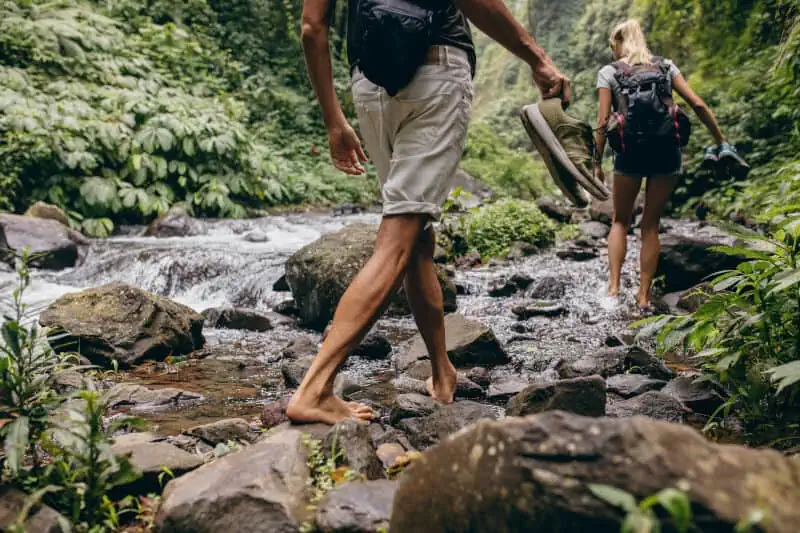
FAQ’s About Barefoot Hiking
This FAQ section is designed to address common questions and concerns about barefoot hiking. Whether you’re a seasoned hiker curious about this minimalist approach or a beginner looking to take your first steps into the world of barefoot trekking, these FAQs provide valuable insights and practical advice to help you safely and enjoyably navigate this intriguing activity.
Is Barefoot Hiking Safe?
Barefoot hiking can be safe if done responsibly. It’s important to start slowly, allowing your feet to adapt to different surfaces. Ensure you’re hiking in areas free of harmful objects like sharp rocks or glass. Additionally, gradually increase the difficulty of trails to build your foot strength and awareness.
What Are the Benefits of Barefoot Hiking?
Barefoot hiking offers several benefits, including improved balance, stronger foot muscles, enhanced sensory perception, and a deeper connection with nature. It can also help in correcting posture and gait, as you learn to walk more naturally without the constraints of shoes.
How Do I Start Barefoot Hiking?
Begin by walking barefoot in safe, controlled environments like your backyard or a clean beach. Gradually increase the complexity and roughness of the terrain. It’s also a good idea to carry a pair of minimalist shoes for situations where going completely barefoot might not be feasible.
What Should I Do to Care for My Feet?
Regular foot care is essential. Keep your feet clean to prevent infections, and inspect them for cuts or bruises. Use natural moisturizers to keep the skin supple. If you encounter any serious foot pain or injury, consult a healthcare professional.
Can I Hike Barefoot in All Terrains?
While barefoot hiking is possible in various terrains, it’s not advisable in extremely rugged or hazardous areas, like sharp rocky paths or heavily forested areas with potential for animal encounters. Assess each trail carefully and use common sense to determine if it’s suitable for barefoot hiking.
How Long Does It Take to Get Used to Barefoot Hiking?
The adaptation period varies from person to person. Some may take a few weeks, while others might need several months. Listen to your body and progress at a pace that feels comfortable and safe for you.
Are There Any Special Techniques for Barefoot Hiking?
Yes, barefoot hiking requires different techniques. Focus on shorter, lighter steps and use the balls of your feet to absorb impact. Be mindful of where you step and how your foot lands to avoid injury.
What if I Encounter Rough or Painful Surfaces?
If you encounter surfaces that are too rough or painful, it’s wise to put on shoes or switch to a different path. Always prioritize your safety and comfort. Carrying a pair of minimalist shoes for such situations is a good practice.
Is Barefoot Hiking Suitable for Everyone?
Barefoot hiking isn’t for everyone. Those with certain medical conditions, like diabetes, which affects foot sensitivity, or people with severe flat feet, should consult a healthcare professional before attempting barefoot hiking.
How Can I Connect with Other Barefoot Hikers?
To connect with other barefoot hikers, look for local hiking groups or online communities. These platforms can offer support, advice, and companionship for your barefoot hiking adventures. Sharing experiences and learning from others can greatly enhance your journey.
How Does Barefoot Hiking Impact Joint Health?
Barefoot hiking can potentially improve joint health by promoting natural gait and foot mechanics, reducing the stress on knees, hips, and the back. However, it’s important to transition slowly and listen to your body to avoid overexertion or injury.
What Types of Terrain are Best for Beginners?
Beginners should start with soft, even terrains like grass, sand, or well-maintained dirt paths. These surfaces are more forgiving and allow your feet to gradually adapt to the sensations and demands of barefoot hiking.
Can Barefoot Hiking Improve Foot Problems?
Barefoot hiking can strengthen foot muscles and improve issues like flat feet and plantar fasciitis over time. However, it should be approached with caution and potentially in consultation with a healthcare professional, especially for those with pre-existing foot conditions.
What Precautions Should I Take Before a Barefoot Hike?
Inspect the trail for potential hazards like sharp objects or toxic plants. Check weather conditions, as extreme temperatures can harm bare feet. Additionally, ensure your tetanus vaccinations are up-to-date, as this can be a risk with cuts or punctures.
How Do I Handle Critters and Insects While Hiking Barefoot?
Stay aware of your surroundings and watch for insects, snakes, and other critters. In areas known for these hazards, consider wearing protective footwear. Applying insect repellent on your legs can also help deter bugs.
Is There a Risk of Getting Parasites or Infections?
While the risk is generally low, it’s possible to contract parasites or infections through cuts or wounds on your feet. Avoid hiking barefoot in areas known for such risks and always clean and inspect your feet after a hike.
How Should I Deal with Cuts or Blisters?
Clean any cuts or blisters immediately and apply a bandage. Monitor for signs of infection like redness, swelling, or pus. In case of severe cuts or if an infection is suspected, seek medical attention.
What Should I Do if My Feet Get Too Cold or Hot?
If your feet become uncomfortably cold or hot, it’s important to address it immediately to prevent frostbite or burns. Use protective footwear in extreme temperatures and take breaks to allow your feet to recover.
Can Children Go Barefoot Hiking?
Yes, children can enjoy barefoot hiking, often adapting quicker than adults. However, it’s crucial to supervise them closely, choose appropriate trails, and ensure their feet are checked regularly for injuries or discomfort.
What’s the Best Way to Build Endurance for Longer Barefoot Hikes?
Start with short hikes and gradually increase the distance as your feet become stronger and more accustomed to different terrains. Incorporating foot strengthening exercises and regular barefoot walking into your daily routine can also help build endurance.
The Bare Essentials: A Foot’s Journey
As we reach the end of our exploration into the world of barefoot hiking, we’ve uncovered a wealth of insights, balancing the allure of a naturalistic approach with the practicalities and precautions it necessitates.
Embracing Our Roots
We’ve learned that human feet are inherently designed for barefoot walking, equipped with a complex architecture of bones, muscles, and nerves. This design suggests that, under the right conditions, barefoot hiking can potentially strengthen the feet, improve balance, and enhance sensory perception.
Weighing the Benefits with Caution
Scientific studies, while limited in number, provide some evidence of the biomechanical and strength benefits of barefoot activities. However, these studies also emphasize the individual variability in response and the importance of a gradual transition to barefoot hiking to minimize injury risks.
Potential Risks on the Trail
Our journey also highlighted the potential dangers of barefoot hiking, such as the risks of splinters, injuries, and encounters with harmful plants and animals. These dangers underline the importance of being well-prepared and choosing trails wisely.
Training for the Barefoot Trail
The path to barefoot hiking is not a sprint, but a marathon. Gradual conditioning of the feet, mindful walking, and incremental exposure to varied terrains are crucial steps in preparing for a safe and enjoyable barefoot hiking experience.
A Personal Journey
Ultimately, the decision to hike barefoot is a deeply personal one. It’s a choice that calls for an understanding of one’s own body, a respect for the natural environment, and a willingness to engage with the world in a more primal and connected way.
The Barefoot Path Forward
As you consider stepping onto this path, remember that the journey of barefoot hiking is as much about the discovery of the external landscapes as it is about an inward exploration of your own capabilities and limits. Whether you choose to fully embrace barefoot hiking or incorporate elements of it into your outdoor adventures, the journey promises to be as enlightening as it is natural.

